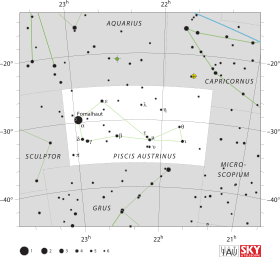Eta Piscis Austrini
Eta Piscis Austrini (η Piscis Austrini) is binary star[3] system in the southern constellation of Piscis Austrinus. As of 2000, the two components had an angular separation of 1.818 arc seconds along a position angle of 113.4°. The pair have a combined apparent visual magnitude of +5.43,[2] which is bright enough to be seen with the naked eye. Based upon an annual parallax shift of 3.99 mas as seen from the Earth,[1] the system is located roughly 820 light years from the Sun.
 | |
| Observation data Epoch J2000.0 Equinox J2000.0 (ICRS) | |
|---|---|
| Constellation | Piscis Austrinus |
| Right ascension | 22h 00m 50.22537s[1] |
| Declination | −28° 27′ 13.4639″[1] |
| Apparent magnitude (V) | +5.43[2] (5.742 + 6.825)[3] |
| Characteristics | |
| Spectral type | B8 V[4] or B7 IVe[5] |
| U−B color index | −0.30[2] |
| B−V color index | −0.10[2] |
| Astrometry | |
| Proper motion (μ) | RA: +15.57[1] mas/yr Dec.: −1.03[1] mas/yr |
| Parallax (π) | 3.99 ± 0.48[1] mas |
| Distance | approx. 820 ly (approx. 250 pc) |
| Absolute magnitude (MV) | −1.53[5] |
| Details | |
| η PsA A | |
| Mass | 4.01±0.18[4] M☉ |
| Luminosity | 604[4] L☉ |
| Surface gravity (log g) | 3.84[6] cgs |
| Temperature | 11,272[4] K |
| Rotational velocity (v sin i) | 265[4] km/s |
| Age | 115[6] Myr |
| Other designations | |
| Database references | |
| SIMBAD | data |
The magnitude 5.7 primary, component A,[3] is a blue-white hued Be star[6] with a stellar classification B8 V.[4] At the age of 115,[6] the star is spinning rapidly with a projected rotational velocity of 265.[4] It has an estimated four times the mass of the Sun and is radiating 604 times the solar luminosity at an effective temperature of 11,272 K.[4] The secondary, component B, has a visual magnitude of 6.8.[3]
Eta Piscis Austrini is moving through the Galaxy at a speed of 11.3 km/s relative to the Sun. Its projected Galactic orbit carries it between 23,600 and 30,800 light years from the center of the Galaxy.[8]
References
- van Leeuwen, F. (2007), "Validation of the new Hipparcos reduction", Astronomy and Astrophysics, 474 (2): 653–664, arXiv:0708.1752, Bibcode:2007A&A...474..653V, doi:10.1051/0004-6361:20078357.
- Feinstein, A.; Marraco, H. G. (November 1979), "The photometric behavior of Be Stars", Astronomical Journal, 84: 1713–1725, Bibcode:1979AJ.....84.1713F, doi:10.1086/112600.
- Fabricius, C.; Makarov, V. V. (April 2000), "Two-colour photometry for 9473 components of close Hipparcos double and multiple stars", Astronomy and Astrophysics, 356: 141–145, Bibcode:2000A&A...356..141F.
- Zorec, J.; Royer, F. (January 2012), "Rotational velocities of A-type stars. IV. Evolution of rotational velocities", Astronomy & Astrophysics, 537: A120, arXiv:1201.2052, Bibcode:2012A&A...537A.120Z, doi:10.1051/0004-6361/201117691.
- Anderson, E.; Francis, Ch. (2012), "XHIP: An extended hipparcos compilation", Astronomy Letters, 38 (5): 331, arXiv:1108.4971, Bibcode:2012AstL...38..331A, doi:10.1134/S1063773712050015.
- Zorec, J.; et al. (October 2005), "On the evolutionary status of Be stars. I. Field Be stars near the Sun", Astronomy and Astrophysics, 441 (1): 235–248, arXiv:astro-ph/0509119, Bibcode:2005A&A...441..235Z, doi:10.1051/0004-6361:20053051.
- "eta PsA -- Be Star", SIMBAD Astronomical Database, Centre de Données astronomiques de Strasbourg, retrieved 2017-05-18.
- Eta Piscis Austrini (HIP 108661)